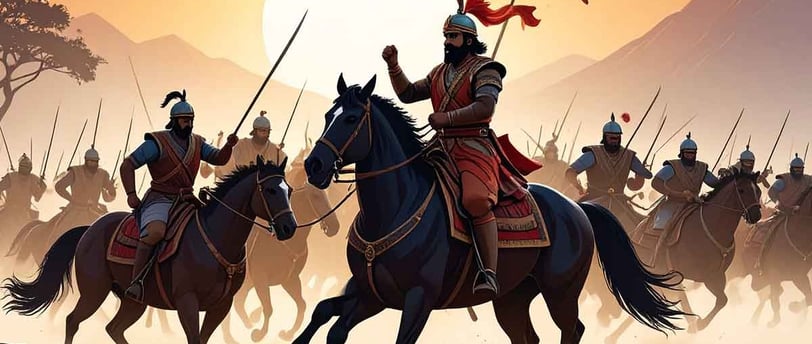The Dāśarājña War/The Battle of 10 Kings: World's First Recorded Battle
An exploration of the earliest known conflict in the Rigvedic era and its legacy.
5/10/20253 min read


The word Dasharaja usually signifies that the war happened between 10 kings/chiefs but in Sanskrit and in Vedas, the words like Dasha and Shata were used to symbolise a large quantity. Therefore, this war can be considered a conflict between a large group of kingdoms and not exactly number 10.
King Sudas emerged as the winner of the war.
One side of the war included King Sudas Paijavana, the chief of the Bharata clan. Another family allied with Bharata was Trutsu whose seer was Rishi Vasistha. Vasistha was a mighty spiritual authority in the success of Sudas.
The opposite party consisted of Dasharaja or 10 kings - Puru, Yadu, Turvasha, Anu, Druhyu, Alina, Paktha, Bhalanas, Alina, Vishanin, Shiva, Vaikarna, Matsya, Shimyu, Bheda, Aja, Shigru, Yakshu, Bhrigu, Kavasha etc. (The numbers are more than 10)
The Dasharajas once attacked the Sudas and Trutsu families. Sudas and his army were cornered by the Dasharaja army on the banks of the river Parushni. Sudas escaped to the other bank with his army due to the blessings of Indra at the behest of Vasistha. Dasarajas tried to cross but they drowned in the river because of the flood sent down by Indra. Some of them tried to make the river shallow by digging channels in different directions and thus dividing the mainstream but they failed in this venture. Some of them were taken by the forceful current and those who managed to cross were killed by Sudas and his army. Some of the Dasharajas tried to flee and left their valuables to be scrounged by the victors.
Indra was believed to be the warrior god by Vedic Indians and if one praised and requested him, he would come to one’s aid. Therefore, In Vedic texts, during fights, we came across appeals to Indra for success. However, what happens when both the parties appeal to Indra? Here, the role of spiritual advisors or sages comes into play, the party with the superior priest usually won the battle, such was the belief of the Vedic folks. Sudas won by the chanting of Mantras by Vasistha. Divine Intervention by Indra and Spiritual Advice by a guru was Part and Parcle of the Vedic warfare.
Professor Ramchandra Narayan Dandekar who was a great indologist and specialised in Vedic studies opined that Puru, Anu, Druhyu, Turvasha and Yadu were the 5 clans after which the concept of Panchajanya/5 communities was established. There were other clans but they followed a non vedic lifestyle, therefore, the Vedic era has witnessed a Vedic as well as a non Vedic system of existence in the same region. Dandekar stated that Sudas was the leader of Bharatas and was an ambitious man who aimed at bringing Panchajanya and Non-Vedic principalities under his control and thereby established the sovereignty of Bharatas throughout the Sapta Sindhu. Professor HD Velankar said that “We do not get here any information about the actual fight between the 2 parties, but only the frustration of the attempts of the powerful enemy to overpower Sudas and his Bharatas” The shlokas do not give a clear picture of why the war happened. Some scholars say that when Vishwamitra was removed by Sudas as the chief priest, he urged Dasharajas to form an alliance and attack Sudas.
It is true however that Vishwamitra did not continue as the royal priest of Sudas but there is no concrete evidence that it was an action of revenge and there is no mention of Vishwamitra in the actual description of the war. From numerous theories certain things are accepted. Paktha - One of the Dasharaja family. Their family is identified from the modern day Pashtunistan region on the Northwest border of Pakistan. Parushni River - It is the river Ravi The existence of Yamuna river which is also called Yamuna in Rig Veda
